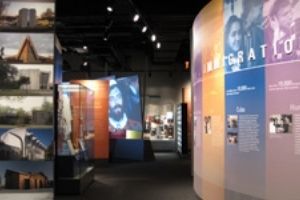CAJM Conference Wrap Up


Professional development is a valued activity at the JMM. Staff members are encouraged to attend lectures, workshops, and conferences. The benefits of learning new skills from experts in the field help us grow in our jobs as we gather information and resources that we bring back with us. Furthermore, these programs often provide opportunities to network with colleagues from institutions – large and small – from across the country and to learn about interesting and innovative programs taking place at other museums. While the benefits of these kinds of programs are obviously, it can sometimes be challenging figuring out a strategy for implementing what you have learned as it is so easy for the materials you gathered and notes you’ve taken to get buried as you return to the piles of work, phone messages, and emails that accumulate while you are away from your desk. Recently, I had the chance to attend Our Stories, Our Museums: New Chapters For Jewish Culture, the annual conference of the Council of American Jewish Museums along with several of my colleagues.

The tote bag that I received from the conference was filled with legal pads with notes scribbled furiously upon them from the sessions that I attended as well as resource materials distributed by session speakers, not to mention program brochures picked up from other museums. The bag sat untouched under my desk for a couple of weeks. Finally, I started going through materials and sat down to review my notes.

One of the difficult decisions you often have to make at conferences is deciding which program to attend as multiple sessions are scheduled simultaneously. Do you attend the session with a panel comprised of several renowned museum professional sharing their collective wisdom from many years in the field or the session devoted to fundraising 101 complete with practical hands-on ideas? Go to workshop geared to my specific responsibilities at the JMM or a panel discussion on interesting topics about the museum field in general. Fortunately, as I went through my notes, I realized that because several other JMM staff members attend the conference and had the foresight to “divide and conquer” each of us had attended different sessions so we could share what we had learned with the larger group. We all decided to meet one day over lunch to compare notes and resources from the sessions that we had attended. This proved to be a wonderful strategy for reviewing session content and to continue brainstorming how we might collectively implement some of the ideas gathered at the conference.

Of particular interest to our group was a session that I attended devoted to the topic, Turning Stories Into History: Transforming the Narrative Through Oral History and Digital Storytelling. Three speakers – representing three different Jewish museums (from New York, Connecticut, and Denver) discussed three very different techniques for incorporating oral history interviews and personal stories into exhibitions, films, and other programs. One of the speakers, Deanne Kapnik from the Mizel Museum in Denver, spoke about a new museum initiative, the Community Narratives Project, a collection of digital stories gathered from a broad cross section of Denver’s Jewish community that have become a key feature of a new permanent exhibit, 4,000 Year Road Trip: Gathering Sparks. (To learn more about this program, visit the Museum’s website.) This initiative resonated with our staff, as we have been working to develop creative ideas for how to develop new programs that integrate storytelling and oral history interviews for audiences of all backgrounds. This is definitely a program that we intend to learn more about as we move forward with our plans.
While many museums have been forced to cut back on professional development activities out of economic necessity, I am proud to work for an institution where professional development is still considered a priority. The benefits for both the staff attending as well as the institution are many – learning best practices from other professionals, gathering resources for programming and exhibit development, and meeting and networking with colleagues from other institutions.
